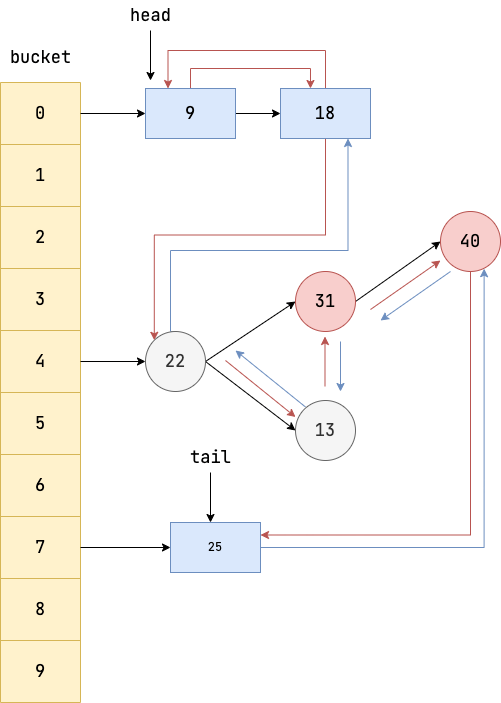| title | category | tag | |
|---|---|---|---|
LinkedHashMap Source Code Analysis |
Java |
|
LinkedHashMap is a collection class provided by Java that extends HashMap and maintains a doubly linked list on top of HashMap, giving it the following characteristics:
- Supports ordered iteration according to the insertion order.
- Supports ordering by access order, suitable for encapsulating LRU cache tools.
- Because it uses a doubly linked list to maintain nodes, the efficiency of traversal is proportional to the number of elements, making iteration much more efficient compared to
HashMap, which is proportional to capacity.
The logical structure of LinkedHashMap is shown in the diagram below. It maintains a doubly linked list between each node on top of HashMap, allowing nodes, linked lists, and red-black trees that are originally hashed into different buckets to be associated in an ordered manner.
As shown below, we add elements to LinkedHashMap in order and then iterate through them.
HashMap < String, String > map = new LinkedHashMap < > ();
map.put("a", "2");
map.put("g", "3");
map.put("r", "1");
map.put("e", "23");
for (Map.Entry < String, String > entry: map.entrySet()) {
System.out.println(entry.getKey() + ":" + entry.getValue());
}Output:
a:2
g:3
r:1
e:23It can be seen that the iteration order of LinkedHashMap is consistent with the insertion order, which is not the case with HashMap.
LinkedHashMap defines a sorting mode accessOrder (boolean type, default is false). When accessOrder is true, the order is based on access; when false, it is based on insertion.
To achieve iteration in access order, we can use the LinkedHashMap constructor that takes the accessOrder parameter and set accessOrder to true, indicating that it has access order.
LinkedHashMap<Integer, String> map = new LinkedHashMap<>(16, 0.75f, true);
map.put(1, "one");
map.put(2, "two");
map.put(3, "three");
map.put(4, "four");
map.put(5, "five");
// Access element 2, this element will be moved to the end of the list
map.get(2);
// Access element 3, this element will be moved to the end of the list
map.get(3);
for (Map.Entry<Integer, String> entry : map.entrySet()) {
System.out.println(entry.getKey() + " : " + entry.getValue());
}Output:
1 : one
4 : four
5 : five
2 : two
3 : threeIt can be seen that the iteration order of LinkedHashMap is consistent with the access order.
From the previous example, we can see that we can encapsulate a simple LRU (Least Recently Used) cache using LinkedHashMap, ensuring that when the stored elements exceed the container capacity, the least recently accessed elements are removed.
The specific implementation idea is as follows:
- Inherit from
LinkedHashMap; - In the constructor, set
accessOrderto true, so that when accessing elements, the element will be moved to the end of the list, and the first element of the list will be the least recently accessed; - Override the
removeEldestEntrymethod, which returns a boolean value to informLinkedHashMapwhether to remove the first element of the list (the cache capacity is limited).
public class LRUCache<K, V> extends LinkedHashMap<K, V> {
private final int capacity;
public LRUCache(int capacity) {
super(capacity, 0.75f, true);
this.capacity = capacity;
}
/**
* Returns true if size exceeds capacity, informing LinkedHashMap to remove the oldest cache entry (i.e., the first element of the list)
*/
@Override
protected boolean removeEldestEntry(Map.Entry<K, V> eldest) {
return size() > capacity;
}
}The test code is as follows. The author initializes the cache capacity to 3 and then adds 4 elements in order.
LRUCache<Integer,
